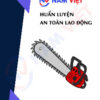Occupational Safety Training for Operating a Band Saw
99,000 ₫
Note: The above price is calculated for one person and may vary depending on the number of trainees participating in the course and market fluctuations. For more accurate pricing support, please refer to the price list or contact our consultants directly.
Occupational safety is an important issue when operating a band saw and needs to be addressed promptly to ensure the health and safety of workers and enhance the reputation of businesses here. The Occupational Safety Training course is one of the effective solutions to raise awareness on preventing workplace accidents for workers when operating a band saw.
Table of Contents
Toggle1. Overview of the Band Saw
a. What is a Band Saw (Metal Band Saws)?
A band saw, also called a “metal band saw” in English, is a type of saw used to cut and divide metal sheets and other metal materials. The band saw operates using a continuous loop blade or saw wire, made of hard steel or metal alloy, which rotates in a continuous loop.
Band saws can be used to cut metals such as steel, aluminum, copper, and various other alloys. They are commonly used in metal workshops, mechanical fabrication, and other applications requiring precise and efficient metal cutting.
The advantages of a band saw include the ability to cut metal sheets with high accuracy and to adjust the cutting angle for angled or bevel cuts. It also saves time and effort compared to manual hand cutting.

b. How a Band Saw Works
The working principle of a band saw involves using a continuous loop blade or saw wire that operates in a continuous loop to cut metal sheets or other materials. The main steps are:
- Starting the machine: The user turns on the band saw and ensures it is set up and adjusted properly for the specific cutting task.
- Adjusting the cutting angle (optional): Band saws often allow angle adjustments, enabling the user to cut at different angles according to the work requirement.
- Loading the material: The metal or other material is placed on the cutting table or clamped in a fixed position to begin cutting.
- Activating the blade: The band saw blade or wire is turned on and begins rotating in a continuous loop.
- Performing the cut: The blade enters the material, cutting along the defined path. Pressure and cutting speed are usually adjusted for efficient and precise cutting.
- Cooling and lubrication: During cutting, the band saw often uses coolant and lubrication to cool the blade and prevent the material from overheating.
- Completing the cut: Once the cutting process is finished, the band saw is turned off, and the material is cut into smaller pieces as required.

c. Industries That Use Band Saws
Band saws are used in many manufacturing industries to cut metal and other materials. Key industries include:
- Mechanical fabrication: Band saws are widely used to cut and process metal parts for machinery, equipment, and other products.
- Metal processing: The metal processing industry uses band saws to cut and divide metal sheets into different sizes and shapes, especially in pipe and sheet production.
- Construction and structural engineering: Band saws are used to cut metal components such as steel pipes, columns, and beams for building structures.
- Automotive manufacturing: Band saws are used to cut and fabricate metal parts for essential car components.
- Aerospace industry: Band saws are used to cut and fabricate metal parts for airplanes and spacecraft.
- Custom metal fabrication: Custom metal workshops use band saws to create specialized metal products and components for unique applications.
- Woodworking and formwork: Band saws can also be used to cut wood and plywood in furniture production and construction.
2. Overview of Safety Training for Operating a Band Saw
a. What is Occupational Safety Training?
- Occupational safety training for operating a band saw consists of sessions that equip workers with awareness and techniques to prevent workplace accidents. Workers who directly operate band saws are classified as Group 3.
- The safety training course helps workers recognize and avoid hazards, reducing the risk of workplace accidents.
REGISTER FOR OCCUPATIONAL SAFETY TRAINING SERVICE
b. Training Duration
Initial Safety Training Duration:
- Total training time is at least 24 hours, including assessment time.
- 8 hours of theory on safety policies and labor hygiene laws
- 8 hours of theory on basic occupational safety and hygiene knowledge
- 4 hours of theory on specialized training content
- 2 hours of practical training on specialized content
- 2 hours of theoretical assessment at the end of the course
The training center schedules sessions depending on workers’ availability, usually in 6 sessions over 3 days if continuous training is possible.
Periodic Safety Training Duration:
- Before the occupational safety card expires, workers must complete periodic safety training, with training duration at least 50% of the initial training duration.
Explanation: The total duration of periodic occupational safety training is at least 12 hours, including assessment. Upon successful completion, the worker’s safety card will be renewed.
c. Training Content
| No. | TRAINING CONTENT | TRAINING DURATION (HOURS) | |||
| Total | Including | ||||
| Theory | Practical | Assessment | |||
| I | Safety policies and occupational hygiene laws | 8 | 8 | 0 | 0 |
| 1 | Overview of legal documents and regulations on occupational safety and hygiene. | 6 | 6 | ||
| 2 | Standards and technical regulations for occupational safety and hygiene. | 1 | 1 | ||
| 3 | Specific regulations from state management agencies on safety when constructing, expanding, or renovating facilities, using and maintaining machinery, equipment, and materials requiring strict safety. | 1 | 1 | ||
| II | Basic occupational safety knowledge | 8 | 8 | 0 | 0 |
| 1 | Basic knowledge of hazards in the workplace. | 4 | 4 | ||
| 2 | Methods to improve working conditions. | 1 | 1 | ||
| 3 | Safety culture in production and business. | 1 | 1 | ||
| 4 | Rights and responsibilities of employers and employees; policies on occupational safety; roles of safety officers. | 1 | 1 | ||
| 5 | Occupational safety rules, signs, usage of protective equipment; first aid skills and occupational disease prevention. | 1 | 1 | ||
| III | Specialized training content | 6 | 4 | 2 | 0 |
| Comprehensive knowledge of machinery, hazardous substances; risk analysis, management, and safe working procedures. | 6 | 4 | 2 | ||
| IV | End-of-course safety assessment | 2 | 2 | 0 | 0 |
| Total | 24 | 22 | 2 | ||
See more training content of the 6 groups
d. Occupational Safety Card
Upon completion of the safety training and passing the assessment, workers will be issued an occupational safety card (commonly called Group 3 safety certificate).
The Group 3 safety card shows the worker’s full name, date of birth, job, and working environment, along with training duration, official seal, and signature.
According to Decree 44/2016/ND-CP, Article 24, issuing safety cards has two cases:
- If the worker has an employment contract with the employer, the employer must sign and stamp the safety card after training and assessment.
- If the worker is freelance or temporary with no employment contract, the training unit must sign and stamp the card after training and assessment.

3. Hazards When Operating a Band Saw
Operating a band saw can pose several hazards to the user, so following safety rules is very important. Here are some common hazards when operating a band saw:
- Physical injuries: A band saw has a sharp, fast-moving blade, so there is a high risk of injury if safety measures are not followed. Risks include cuts, scratches, or injuries from the saw blade.
- High temperature: The cutting process can generate high temperatures, causing burn risks if users come into direct contact with hot metal materials or machine parts.
- Electric shock: Band saws operate on electricity, so there is a risk of electric shock if there is contact with unsafe wiring or a wet environment.
- Noise: Band saws produce loud noise, and not using hearing protection can harm the user’s hearing.
- Working conditions: The work environment can present risks of collapse, slipping, or tripping. Failure to maintain cleanliness and proper machine maintenance can lead to accidents.
- Saw blade: The band saw blade can wear, break, or misalign during use, creating a hazard. Regular inspection and maintenance of the blade are necessary.
- Failure to follow safety rules: Not wearing safety glasses, protective clothing, following the manufacturer’s instructions, or receiving proper training can result in serious hazards.
To reduce the risk of accidents when operating a band saw, users should always follow safety rules and receive proper training on how to use the machine. Regular maintenance and inspection of the band saw are also essential to ensure user safety.

4. Measures to Control Workplace Accidents When Operating a Band Saw
To control workplace accidents when operating a band saw, a series of safety measures should be implemented. Here are some important measures:
- Training: Ensure all band saw operators are fully trained on machine operation, safety rules, and emergency procedures. This includes knowing how to operate, inspect, maintain the saw, and respond to dangerous situations.
- Personal protective equipment (PPE): Ensure operators wear appropriate protective gear, including safety glasses, hearing protection, gloves, safety shoes, and heavy-duty clothing when necessary. This helps protect against injuries and high-temperature risks.
- Safe working environment: Keep the work area clean, non-slippery, free from collapse hazards, and remove objects that could cause collisions. Ensure no one stands in the operating zone of the band saw.
- Band saw maintenance: Perform regular maintenance on the band saw, including blade inspection, mechanical checks, and ensuring stable operation.
- Use proper blades: Use the correct blade for the material being cut and ensure it is properly installed and maintained.
- Cooling and lubrication: Ensure the band saw is supplied with adequate cooling and lubrication to cool the blade and prevent metal overheating.
- Electrical safety check: Ensure the electrical system is not damaged or wet and provide necessary protection to prevent electric shock.
- Work supervision: Monitor the cutting process to ensure operators do not perform dangerous actions or ignore safety rules.
- Safety planning: Have emergency response plans in place and ensure users know how to execute them.
- Regular safety inspection: Frequently check the band saw and safety measures to ensure optimal performance and safe operation.
- Periodic inspection of the band saw to detect safety issues such as wear, damage, or mechanical failures, thereby reducing the risk of workplace accidents.
5. Benefits of Occupational Safety Training
An Toàn Nam Việt provides your business with the following benefits after completing occupational safety training courses in accordance with Decree 44/2016/ND – CP on occupational safety and hygiene:
- Employees can recognize potential workplace hazards and take preventive measures to avoid accidents.
- Your business can establish risk prevention measures in production, operation, and maintenance processes.
- Reduce costs associated with workplace safety risks.
- Uninterrupted production helps increase labor productivity and product quality.
- Ensure compliance with labor safety laws and avoid legal risks.
- Create credibility and professionalism in all aspects, enhancing your brand image.
Nam Việt’s training courses are solutions to prevent external hazards from impacting individuals, helping them avoid injuries or even fatalities.
REGISTER FOR OCCUPATIONAL SAFETY TRAINING
6. Customer Feedback After Completing Training
An Toàn Nam Việt has years of experience accompanying businesses across Vietnam, particularly in the southern provinces. This responsibility is invaluable to Nam Việt, which is why our Occupational Safety Training is increasingly professional. Our growth is fueled by positive feedback and suggestions from our corporate partners. Below are testimonials from clients we have served:
See more customer interviews after using services from An Toàn Nam Việt
7. An Toàn Nam Việt’s Occupational Safety Training Capabilities
An Toàn Nam Việt is a reputable and high-quality occupational safety training center in Vietnam, offering continuous training sessions at factories, production sites, and construction sites nationwide (all 63 provinces of Vietnam).
REGISTER FOR OCCUPATIONAL SAFETY TRAINING
Occupational Safety Training License
- An Toàn Nam Việt has been inspected and certified by the Safety Department of the Ministry of Labor – Invalids and Social Affairs as qualified to conduct occupational safety and hygiene training. This further strengthens our training capabilities.

Training Materials
- Before being used in occupational safety courses, training materials are reviewed to ensure accuracy and practical effectiveness.
- Our instructors’ teaching methods follow Nam Việt standards, developed by experts in occupational safety training to maximize knowledge absorption for learners.
Facilities
- Controlling classroom conditions enhances teaching efficiency and learner knowledge retention.
- Our training facilities are spacious and meet standards for area, lighting, and training equipment.
8. Nationwide Reputable Occupational Safety Training Center
At An Toàn Nam Việt, we prioritize professional occupational safety training. Teaching workers to protect themselves equips them with safety knowledge essential for their livelihood and contributes to national development.
We carefully prepare every detail, from tools and teaching equipment to curriculum, documents, audio, and lighting.
Our instructors are experts with years of experience, some conducting research on hazard identification across industries and prevention methods.
Lectures are practical, engaging, and easy to understand. Employees can learn comfortably while absorbing knowledge effectively. All content aligns with Decree 44/2016/ND-CP.
Employees learn preventive measures and how to protect themselves, applying this knowledge practically.
Our training center is proud to provide professional, reputable occupational safety training with the following advantages:
- Competitive training costs with guaranteed quality.
- Flexible training schedule to match company production needs.
- Quick certification paperwork in compliance with law.
- Experienced instructors with many years in the field.
- Controlled classroom conditions to enhance teaching efficiency and knowledge retention.
- Course content tailored to occupational safety in businesses.
- Dedicated and professional support for clients quickly and accurately.

9. Additional Occupational Safety Training Materials
- Occupational Safety Training Material Set
- Band Saw Operation Safety Material
- Occupational Safety Test Set
- Multiple-choice Test for Band Saw Safety
- Band Saw Operation Training Slides
1 review for Occupational Safety Training for Operating a Band Saw
No comments yet















phanminhhang341
Đơn vị chuyên nghiệp về huấn luyện an toàn lao động